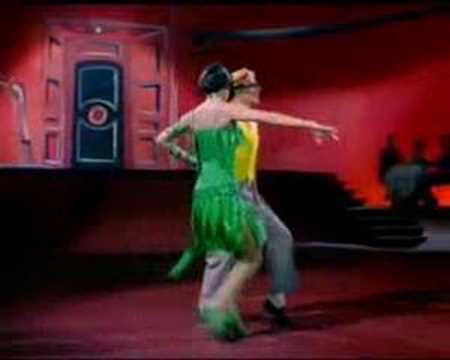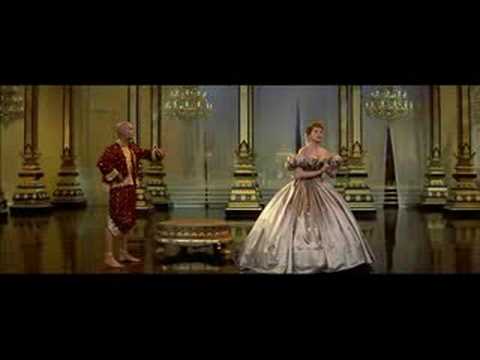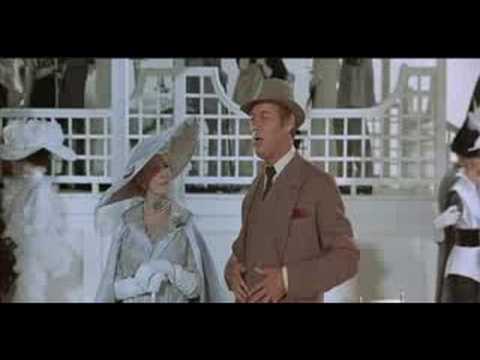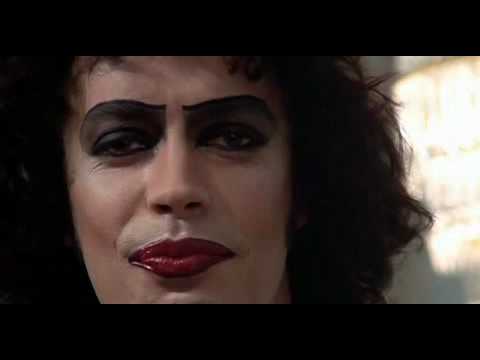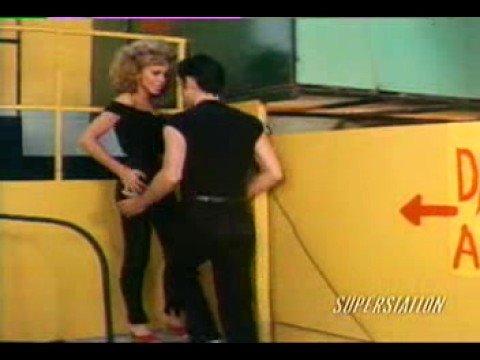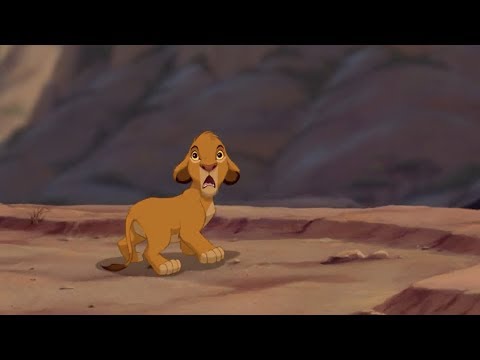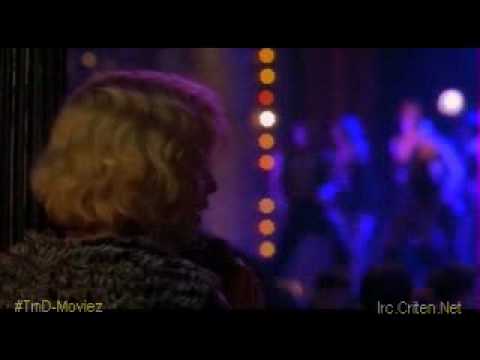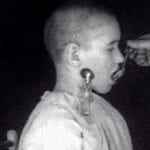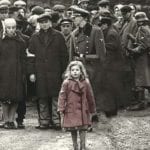Those which are converted to movies are so often completely unable to carry the weight of a stage musical, or to translate the melodrama into something audiences can relate to. This has led to many failures: The Producers (2004), The Phantom of the Opera (2005) and RENT (2005) to name perhaps the most well-known ones. I enjoyed all three of these movies, but more due to an ingrained bias, than because they were good examples of what a musical should or could be. Therefore, they do not appear on this list. What will be here are examples of movie musicals that have brought new life to an old form of entertainment, or have simply been some of the best examples of musical theater ever brought to the screen. They have been praised by both critics and audiences, some even attracting Oscar buzz (and some carrying out the Oscar itself), and will last and still be remembered ten, twenty, even fifty years from now. Don’t forget to hold your applause until the end.
Released in 1952, amidst what is often dubbed the “Golden Age of Musicals”, Singin’ in the Rain has been one of the most lasting examples of musical cinema. Starring Gene Kelly, Donald O’ Connor, Debbie Reynolds, Jean Hagen and a short, but extraordinary, cameo by Cyd Charisse, this musical showcases some of the greatest dancing of its time. Not only this, but it boasts perhaps one of the most recognizable scenes in cinema to date. It was nominated for two Oscars, including a Best Actress in a Supporting Role nomination for Jean Hagen’s performance as the shrewish Lena Lamont. It tells the story of the birth of ‘talkies’ (or talking pictures) in America. The year is 1927, and The Jazz Singer has become a wild success as the first movie to ever showcase its actors singing and talking. Don Lockwood (Gene Kelly) is the star of Monumental Pictures, and has been churning out the hits with his horrible co-star Lena Lamont since his discovery by the studio, when he was just a humble stuntman. Making a talkie wouldn’t be such a difficult task if it wasn’t for Lena’s total lack of talent or grace on screen, now that the unforgiving addition of sound has revealed her worst quality. Memorable Scene: While Gene Kelly’s dance in the rain is fantastic, there are many other brilliant performances. It’s impossible to overlook Cyd Charisse in the role of an unnamed dancer in the “Broadway Melody” montage. She seduces Gene Kelly’s character before breaking his heart, and the audience are undeniably certain of this, even though no lines are spoken. Her jaunty, seductive dance number in an emerald green dress is almost risqué.
This musical was hugely successful at the box office after its release in 1953, but fifty-eight years later Marilyn’s smoldering performance as Lorelei Lee, a gold-digging showgirl, is still widely popular and famous. Mostly thanks to the scene in which she sings “Diamonds Are a Girl’s Best Friend,” while wearing her iconic pink dress. The musical also boasts another, though less well-known sex symbol, Jane Russell, who passed away earlier this year. The movie is practically overflowing with the two women’s sex appeal, and the spectacular costumes and musical numbers. It has been widely celebrated, not just for these reasons, but because it cemented Marilyn’s status as a star. Before Gentlemen Prefer Blondes she was considered a fairly small-time actress, who wasn’t on par with other sex symbols such as Jane Russell and Betty Grable. Afterwards, however, she rocketed to worldwide fame. Memorable Scene: Undoubtedly Marilyn singing “Diamonds Are a Girl’s Best Friend.” She has rarely been so beautiful or seemed so in control during a performance. Despite not being a dancer or singer she radiates grace (and practically overflows with sex appeal) and showcases a surprisingly good voice. The costume and set are dazzlingly bright, but the director is careful to ensure that nothing and no one outshines Marilyn in her most iconic performance, most obvious by his choice to cover the female dancers’ faces with black netting.
The King and I practically exemplifies the sweeping, grandiose stage musical that movie audiences hate, but despite this, it was one of the few of its kind to not only translate extremely well to screen, but achieve both high takings at the box office and positive reactions from audiences and critics. Based in the nineteenth century, it tells the story of Anna Leonowens (Deborah Kerr), an English schoolteacher employed to teach and care for the King of Siam’s (Yul Brynner) children. Despite sometimes showcasing the frequently accepted racial stereotypes of its time, The King and I also showcases many songs which are still well-loved and widely recognized: “Getting To Know You,” “Shall We Dance?” and “I Whistle A Happy Tune” to name a few. The King and I was nominated for a total of nine Oscars (including Best Picture, Best Director and Best Actress), and won 5 of the categories in which it was nominated, including a Best Actor award for Yul Brynner’s performance. Memorable Scene: The most visually and musically splendid scene must undoubtedly be the scene in which the King and Anna waltz (well, do the polka) to the song “Shall We Dance?” It practically oozes with sexual tension. It is the obvious attraction and friendship between the King and Anna that helps make the movie so enthralling, as it clearly would have been widely condemned for the two to be romantically involved in the time the movie is set (or even during the time it was released) and it makes the movie powerful, as well as visually stunning.
My Fair Lady’s beginnings were controversial. Julie Andrews, who had played Eliza Doolittle in the stage production, was first considered for the film role before being almost immediately disregarded. The reasons are speculative; the producers’ explanation was that they thought that casting a stage actress in a multi-million dollar production was too risky. However, it is probable that she just wasn’t considered to possess enough star power for a huge Hollywood musical. Audrey Hepburn was widely considered a beauty, and was already an established actress after her performances in other classics such as Breakfast At Tiffany’s (1961) and Paris When It Sizzles (1964). Other controversies followed, mostly centering on the choice to dub 90% of Audrey Hepburn’s singing parts with Marni Nixon’s voice. A choice that upset Audrey, and is thought to be one of the reasons she was snubbed for an Oscar nomination. However, despite these hiccups the release of My Fair Lady raked in $72,000,000 at the box office, and was nominated for twelve Oscars (including Best Supporting Actor and Best Supporting Actress). It won a staggering eight of those nominations. These wins included Best Picture, Best Director, Best Cinematography and a Best Actor award for Rex Harrison’s performance as Henry Higgins, the arrogant professor of phonetics who makes a bet on his being able to transform a Cockney flower girl into a “proper lady.” Memorable Scene: My Fair Lady brilliantly satirizes class difference, but never more perfectly than in the “race course scene,” where Eliza’s true nature is unfortunately revealed through her inability to hold small talk, instead embarking on a story of how her aunt was “done in” over a straw hat, and then completely losing her head when the race starts.
Despite what many could say was a fairly cold act on the behalf of the producers of My Fair Lady, Julie Andrews went on to star in a very popular and successful musical of her own, in the same year My Fair Lady was released. Mary Poppins really needs no introduction, because I’m almost certain that most people would know this story. If not, it’s about a family in Edwardian England who are visited by what can only be described as a ‘magic nanny.’ As a Disney production, Mary Poppins was almost guaranteed a warm response at box offices, but I doubt anyone could have realized just how lasting the movie would be. The music is excellent, and why wouldn’t it be with a voice like Julie Andrews’ in the title role? It’s doubtful that the musical would have had the same sparkle without Julie Andrews in it. Her beautiful voice is timeless, and effortlessly carries every song. One can also forgive Dick Van Dyke’s horrifically bad Cockney accent and, instead, focus on the warmth and humor he brought to the character of Bert. It’s impossible to tell whether a musical will be embraced like this one has been, but I think its ability to entertain both children and adults is one of its many selling points. The intricate sets help create the atmosphere of stuffy Edwardian London, and the enthusiastic and committed performances from its entire cast, even the two children Jane (Karen Dotrice) and Michael (Mathew Garber), make what could have been a very forgettable musical into something lasting and beloved by many people. It bested My Fair Lady for Oscar nominations, securing a huge thirteen nominations, including Best Picture and Best Director, but only managed to win five. However it was, and still is, the most Oscars ever won by a Disney movie. Julie Andrews took the award for Best Actress, somewhat ironically, given that Audrey Hepburn hadn’t even received a nomination for her role in My Fair Lady. Memorable Scene: So many to choose from. The horse racing scene where Mary, Bert and the two children magically jump into one of Bert’s drawings is lovely, and has two of its many well-loved musical numbers: “Jolly Holiday” and, of course, “Supercalifragilisticexpialidocious” (yes, I copied and pasted that). But I think another stand-out is “Step In Time” when they escape across the roofs of London and meet Bert’s grimy chimney sweeper friends. It’s a great dance sequence. I’m beginning to realize that if you haven’t seen this movie it may be starting to sound like someone’s drug-fueled fantasy, but I assure you it’s a very charming and funny little film, and quite child-friendly.
Alright, I lied. Not all of the movies on this list did well when they were first released in cinemas. Rocky Horror, for example, did very badly. In fact it was a complete flop. However, it very soon atoned for this in earnest. In the late 1970s, it began to be shown at the infamous midnight screenings and quickly gathered a huge cult following worldwide. Since then, it has become the longest running film in theater history, and is still being shown today in cinemas around the world every week. It is though, no doubt, a strange formula for a musical: two “ordinary, healthy kids” (in reality an engaged couple) who find themselves embroiled in a bizarre cat and mouse game with the eccentric scientist Doctor Frank-N-Furter, played by Tim Curry. But no doubt the longevity of this musical has been cemented through this complete disregard for reality or conventional cinema. It satirizes a range of other movies, such as B-Movies, Science Fiction, Horror movies, and even other musicals, while also creating brilliantly catchy songs of its own. The clean-cut, no-nonsense main characters Janet (Susan Sarandon) and Brad (Barry Bostwick) are mercilessly mocked as they are thrown into a situation that is increasingly uncomfortable and bizarre. Tim Curry is perfect as the promiscuous and completely deranged Dr. Frank-N-Furter. Memorable Scene: The “Sweet Transvestite” scene. What else? Tim Curry explodes onto screen wearing very little, completely horrifying the two newcomers, Brad and Janet. There’s something to be said about a man who looks good in nylon. And who can carry a tune that well while wearing heels that high. I’ll also give honorable mentions to “The Time Warp,” which remains a favorite at school formals everywhere, and “Hot Patootie,” which stars Meat Loaf as a disgruntled ex-delivery boy.
Undoubtedly the highest grossing musical in the 1970s, Grease is another movie musical that has been well-loved for decades. This could be due, in part, to its star power. With Olivia Newton-John and John Travolta at the helm as Danny Zuko and Sandy Olsen, it has been blessed with longevity, as many other musical stars can slide into obscurity. But besides this, it also brought the stage musical on which it was based to the screen with enthusiasm and boldness, not shying away from depicting some of the more controversial topics such as teen drinking and smoking, and the character Rizzo’s suspected unplanned pregnancy. It also had a score of well-loved music to rely on, songs like “Summer Nights,” “Greased Lightning” and “You’re The One That I Want.” In fact, “Summer Nights” and “You’re The One That I Want” were both number 1 hits in the UK, and the title song, “Grease” by Frankie Valli, was a number 1 hit in the USA and was specially written for the movie. Memorable Scene: Again, there are so many in this film. It’s undoubtedly one of the best recognized by audiences for its iconic ’50s setting, and the many classic songs it produced. The scene at the prom is a stand-out however, not only because it brings to life the music and atmosphere of the 1950s, but because of the mixture of drama and humor. The commotion of Sandy being usurped by Cha-Cha is soon dampened when a few of the more boisterous youths decide to give new meaning to the song “Blue Moon.”
This musical is a bit different, not only because it’s obviously an animation, but because it is the only film on the list that was originally a film and later was adapted for the stage. The stage production is magnificent, showcasing not only brilliance in acting and singing, but intricate costumes that bring to life the African plains. The musical has won awards both on the stage and the screen, including two Oscars. Often cited as one of Disney’s best creations to date, it focuses on the young lion, Simba, who is thrown into conflict after his evil uncle Scar secures his father’s death. It is based on Shakespeare’s play Hamlet. The film boasts a wide range of talents: Mathew Broderick, Nathan Lane, Rowan Atkinson and Whoopi Goldberg, to name a few, and the makers were clearly dedicated to being as realistic and loyal in their depiction of Africa as possible. The story is also noteworthy for its tragedy and realism. Death is never far on the African plains Simba roams, and there are some truly evil and destructive characters who wish the young prince harm. Its Shakespearean roots help found a truly moving and dramatic storyline, while the music is simply beautiful. It doesn’t feel like it was added as an afterthought, as it can in many other animated films, but instead feels deeply rooted into the storyline. Memorable Scene: I think it’s necessary to mention both a musical and non-musical moment. I particularly think that the “Be Prepared” song is a brilliantly effective and visually rich scene, which also serves to make the intentions of Scar very clear to the audience. A non-musical scene that has frequently captured audiences’ imaginations is one shortly after Simba’s misadventure with the hyenas, where his father Mufasa describe the stars to Simba as “past kings” and teaches Simba about his future as king.
Moulin Rouge is another exception on this list. It wasn’t, and still isn’t, a stage musical, but it is certainly a musical worth noting. Starring Nicole Kidman and Ewen McGregor, this musical breaks the mold of the traditional musical, instead injecting modern music to create what is known as a “jukebox musical.” Though these musicals are often criticized for relying too heavily on already established music, or simply dumping music into the mix, Moulin Rouge skillfully used the modern music to both enhance the storyline and create the vivid, colorful surroundings of the Parisian brothel, the Moulin Rouge. The story centers on Christian, the archetypal “penniless writer” who believes in truth, beauty, freedom and most of all love. He falls hard for Satine, a beautiful courtesan working in the Moulin Rouge, but he is not her only admirer. One of the most refreshing aspects of this musical is that all of the singing is done by the actors themselves. Nicole and Ewan’s vocals are surprisingly good, and they carry the songs extremely well. In Baz Luhrmann’s trademark style, the musical numbers are sweeping and dramatic, and the scenery is so vivid and splendid that it’s almost claustrophobic. There is so much to look at that it almost becomes overwhelming, but this perfectly embodies the atmosphere of what the Paris nightlife must have been like in 1900. It was nominated for eight Oscars, including Best Picture, Best Actress and Best Cinematography, and also won a slew of other awards, including three Golden Globes and a BAFTA for Jim Broadbent’s performance. Memorable Scene: The finale is noteworthy for its sweeping music, and stunning visuals, as well as its dramatic and tragic crescendo. Christian’s introduction to the underworld of Paris is also a brilliant scene, both for the color and magnificence of it and also for Ewen McGregor’s appropriately “rabbit in the headlights” reaction to his first view of Satine. Nicole Kidman pays homage to Marilyn Monroe, singing “Diamonds Are a Girl’s Best Friend,” but taking a jauntier, more modern approach to the classic.
The only musical since 1968 to win Best Picture, Chicago renewed audiences’ interest in musicals and followed Moulin Rouge’s example of making musicals grittier, sexier and, therefore, more appealing to modern movie-goers. At the helm were Renee Zellweger, Catherine Zeta-Jones and Richard Gere, who not only did all their own singing, but also underwent training so they could do all of their own dancing. I would even go so far as to say that this was better than the stage production. It has a grittiness to it and a large scale that seems a bit quaint and squashed on the stage. The story itself tells of two murderesses, Velma Kelly (Catherine Zeta-Jones) and Roxie Hart (Renee Zellweger) who are sent to Cook County Jail for murder. Velma is a nightclub dancer who is arrested for shooting her husband and sister after finding them in bed together, and Roxie is a wannabe star who shoots her boyfriend to death after he fails to make good on his promise to make her famous. Under the watchful eye of Matron “Mama” Morton (Queen Latifah), they both hatch plans to slip out of the law’s clutches, with the help of the lawyer Billy Flynn (Richard Gere). This musical was almost certainly successful because of its wise use of musical numbers. Many people dislike the use of “sang dialogue” outside of a theater, and like the other musicals on this list, Chicago used music to color the environment and provide entertainment rather than just to advance the storyline, which can often be dull and slow moving. Its numbers are jaunty and provocative and extremely catchy. Notable numbers are: “Funny Honey,” where Roxy sings about how she can always rely on her slow-witted husband to take the blame for her, “All That Jazz,” an introduction to the risqué© antics of Velma Kelly at her night club, “Cell Block Tango,” a montage of all the ladies of murder row and their various violent crimes, and “Hot Honey Rag,” Velma and Roxy’s finale. But almost all of the numbers are catchy and visually interesting; there isn’t a sense of any particular song being a “boring number.” Perhaps because there is very little sentimentality in this film, and even less reliance on using the music purely to advance the story. As I said before, this film carried out the Best Picture in 2002. Something that has annoyed a lot of people since, which is a good example of the reception most musicals are greeted with. They are often thrown into the same basket as comedies when it comes to the Academy Awards, and have certainly not been popular with the Academy since the late 1960s. Memorable Scene: I find it difficult to choose one, but I think Cell Block Tango is excellent. It’s got the right amount of sex appeal and shock factor, and the dancing is brilliant. The entire cast are extremely talented.
If I was forced to choose a favorite musical of these, I would probably choose Sweeney Todd. I stress that “probably.” This is another example of the “musicals for people who hate musicals” genre that Chicago and Moulin Rouge belong to. But instead of sex, it uses blood to woo its audiences. Lots and lots of blood. Although, admittedly, this is probably more a result of its having Tim Burton as director, who has never been shy when it comes to gruesome violence. Either way, Sweeney Todd translated extremely well from its origins on the stage, in which Angela Lansbury (the teapot in “Beauty and the Beast” for those of you who don’t avidly follow the never-ending reruns of “Murder, She Wrote”) played Mrs Lovett. The movie has an absolutely superb cast of its own, showcasing some great young English talent, as well as some well-established talent: Johnny Depp and Helena Bonham Carter at the helm, with Alan Rickman, Timothy Spall and Sacha Baron Cohen (yes, the guy who played Borat) as equally excellent co-stars. The story is set in Victorian London and Tim Burton has lovingly crafted the grimiest, grittiest, most grim world he could imagine. Sweeney Todd has returned from Australia after serving fifteen years for an unnamed crime he did not commit. He was wrongfully convicted by Judge Turpin (Alan Rickman) who is an extremely rich and powerful sexual deviant, who had his eye on Sweeney’s wife. Sweeney returns to London just wanting to find his wife again, but he returns to find his house empty, his wife dead and his daughter in the clutches of the man who destroyed his life. Sweeney flies into a rage and begins to make plans to slaughter the judge, and anyone else unfortunate enough to get in his way. It is extremely dark. Unlike many other musicals it doesn’t shy away from blood, violence and extremely dark themes. But despite its grimness, there is a lot that is visually splendid about this movie. It might seem odd to claim that, because the scenery does appear to be quite drab and washed out, but Sweeney’s bloody vengeance on every man who has the misfortune to come to him for a shave is almost artistic in its violence and bloodiness. Memorable Scene: The montage of Sweeney slitting his customers’ throats while singing about his pain at losing his wife and daughter is haunting but also quite funny, but “A Little Priest” is a brilliant example of Johnny Depp’s ability to lose himself almost completely in his character. In this scene he and Mrs Lovett devise a plan to rid themselves of the bodies that could start piling up if they don’t find a suitable manner of disposing of them. Luckily, Mrs Lovett has a delectable plan.
